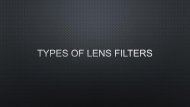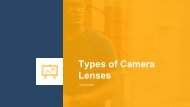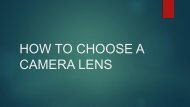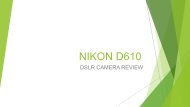Photography lighting-basics
Just started with flash photography? No idea how to carry on? Here are a few slides on the basics of lighting in photography. Full guide - http://xlightphotography.com/photography-lighting-basics/
Just started with flash photography? No idea how to carry on? Here are a few slides on the basics of lighting in photography. Full guide - http://xlightphotography.com/photography-lighting-basics/
- TAGS
- photography
Create successful ePaper yourself
Turn your PDF publications into a flip-book with our unique Google optimized e-Paper software.
PHOTOGRAPHY<br />
LIGHTING<br />
BASICS
Hello!<br />
I am WS Toh<br />
Being a self-taught photographer, I give<br />
back to the community by giving free<br />
tutorials.<br />
2
“<br />
We can easily forgive a child who<br />
is afraid of the dark; the real<br />
tragedy of life is when men are<br />
afraid of the light.<br />
- Plato<br />
3
Two types of lights<br />
▫<br />
▫<br />
Natural Light: Very obviously, everything that<br />
glows naturally. The sun, moon, fireflies, etc..<br />
Artificial Light: Man-made lights. The light bulbs.<br />
4
5<br />
1) NATURAL LIGHT<br />
All that glows naturally
Different time, different light<br />
Time Light Intensity Color Temperature<br />
Sunrise Very soft Warm<br />
Morning Soft Bluish<br />
Midday Very harsh White<br />
Afternoon Harsh White / Bluish<br />
Sunset Very soft Warm<br />
Twilight Very soft Blue<br />
6
What is so exciting?<br />
• Light changes throughout the day.<br />
• Same scene, but different feel at<br />
different times.<br />
• Best time for photography is usually<br />
sunrise/sunset.<br />
• Soft golden light. Also called the<br />
golden hour.<br />
• Use the lights to your best<br />
advantage.<br />
7
8<br />
2) ARTIFICIAL LIGHT<br />
Man-made lights
Many kinds of artificial lights<br />
Incandescent<br />
The old school bulb,<br />
produces warm light.<br />
Fluorescent<br />
Regular Joe you find<br />
everywhere. Warm or cold.<br />
9
Many kinds of artificial lights<br />
Halogen<br />
Commonly used in cars.<br />
Very bright, very hot.<br />
Flash<br />
Photographer’s best friend.<br />
10
Many kinds of artificial lights<br />
LED Panel<br />
The upcoming new<br />
technology. Getting more<br />
popular.<br />
Strobe<br />
The big guns commonly<br />
used in studios.<br />
11
What is the big deal?<br />
Just like natural light, each artificial light produces different light qualities.<br />
Type Light Intensity Color Temperature<br />
Incandescent Soft Warm<br />
Fluorescent Harsh Warm / Cold<br />
Halogen Very Harsh Almost neutral<br />
Flash Very Harsh Almost neutral<br />
LED Soft Warm / Cold<br />
Strobe Very Harsh Almost neutral<br />
12
How to measure light<br />
Guide Number (GN): The commonly used quantifier in photography equipment.<br />
Goes by the formula of GN = distance X f-number. Or simply, the higher the<br />
number, the more power the light is.<br />
Lumen and Lux: More commonly used in the industry, but it’s the same higher<br />
number, brighter light.<br />
13
14<br />
3) THE ESSENTIALS<br />
Laws of light that you should know
What happens when light falls on an object?<br />
Shadow: We should already<br />
know this. Dark area where light is<br />
blocked by an opaque object.<br />
Highlight: Opposite of shadow.<br />
Bright area where light directly<br />
falls on.<br />
Core: Transition between highlight<br />
and shadow.<br />
15
Hard VS Soft Light<br />
Hard light: Harsh <strong>lighting</strong> that has<br />
a very defined core and strong<br />
sharp shadows.<br />
Soft light: Gentle <strong>lighting</strong> that has<br />
a smooth core and soft shadows.<br />
16
Square Inverse Law<br />
All serious photographers should<br />
know this. Intensity of light = 1 /<br />
Distance²<br />
Or simply put, the closer the light,<br />
the more focused and stronger it<br />
is.<br />
17
Direction of light<br />
Front Lighting<br />
Side Lighting<br />
Back Lighting<br />
18
Keep Playing With Light!<br />
• Natural light exists almost everywhere.<br />
• Using a flash does not mean natural light no longer exists.<br />
• It just means you have to consider the impact of using flash and<br />
the environmental lights.<br />
• Lighting may seem difficult, but you just have to keep<br />
experimenting!<br />
19
THANKS!<br />
That’s all for the short slides.<br />
You can find me at : http://xlightphotography.com<br />
The original article for these slides:<br />
http://xlightphotography.com/photography-<strong>lighting</strong>-<strong>basics</strong>/<br />
20
CREDITS<br />
Special thanks to all the people who made and<br />
released these awesome resources for free:<br />
Presentation template by SlidesCarnival<br />
Photographs by Startup Stock Photos<br />
21


















